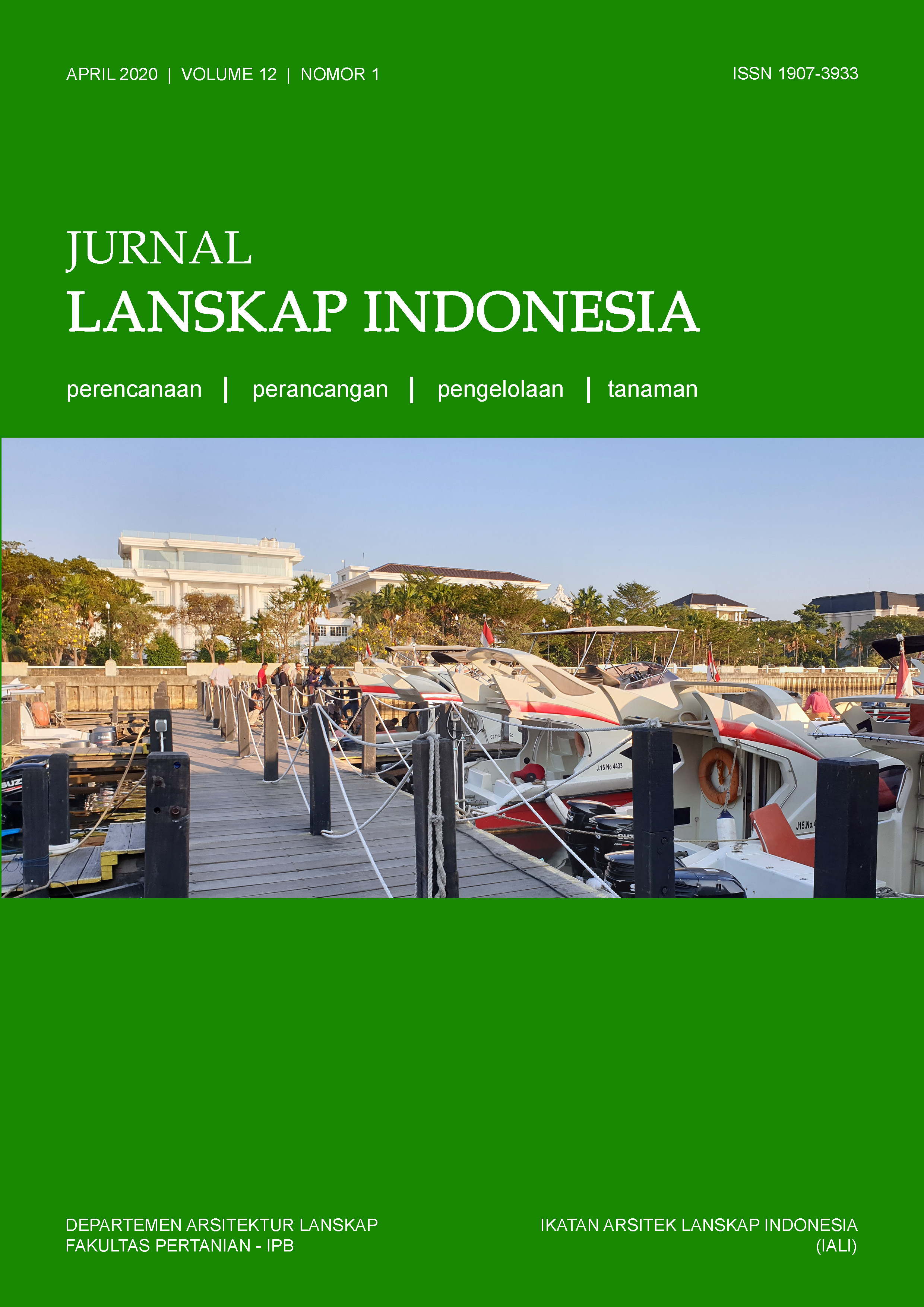Desain Lanskap Ekoriparian Babakan Pasar, Bogor
Abstract
Environmental management, especially the water resources sector in Indonesia is experiencing greater pressure from the use of environmental resources compared to efforts to improve environmental quality. The Ministry of Environment and Forestry (KLHK) has collaborated with society through communities to combine the concept of riparian planning with efforts reducing the pollution load from domestic waste and making the place a center for education and environmental conservation, this concept is called ecoriparian. One of the locations planned for ecoriparian planning is located in the Ciliwung Watershed, located in Babakan Pasar Village, Central Bogor District, Bogor City, West Java. This area is located in a densely populated settlement with a strategic location and is thick with pluralistic values. The approach used in this research refers to Gold's (1980) design process, this stage starts from preparation, inventory, analysis, synthesis, concept and design. The results of this research are expressed in the form of a concept and visual design of the Babakan Pasar Ecoriparian Park which develops potentials on the site, the landscape design uses the Chinese and Sundanese cultural approach as outlined in the spatial concept of elemental form and color selection. In this research, is expected the exsistence of this ecoriparian park can improve the quality of the Ciliwung River, change the mindset of the community regarding river preservation and add to the aesthetic value of an area.
Downloads
References
[KLHK] Kementerian Lingkungan Hidup dan Kehutanan: Biro Perencanaan. 2020. Laporan Kinerja 2019. https://bit.ly/LKJ KLHK 2019
Arifin, H.S., Wulandari, C., Pramukanto, Q., Kaswanto, R.L. 2009. Analisis Lanskap Agroforestri: Konsep, Metode, dan Pengelolaan Agroforestri Skala Lanskap. IPB Press. Bogor, Indonesia.
Baroroh, F., Irawanto, R. 2016. Seleksi Tumbuhan Akuatik Berpotensi Dalam Fitoremediasi Air Limbah Domestik di Kebun Raya Purwodadi. Malang: Prosiding Seminar Nasional Biologi. Universitas Negeri Malang.
Forman, R., Gordon, M. 1983. Lansdcape Ecology. New York: John Wiley & Son.
Gold, S.M. 1980. Recreation Planning and Design. New York: McGraw-Hill Book Co. 568 p.
Hairiah K, Sardjono MA, Sabarnurdin S. 2003. Pengantar Agroforestri. Bogor: ICRAF.
Kurnadi, K.P. 2009. Studi Lanskap Bersejarah Kawasan Pecinan Suryakencana, Bogor. [skripsi]. Bogor: Institut Pertanian Bogor.
Menteri Pekerjaan Umum 2008. Peraturan Menteri Pekerjaan Umum Nomor: 05/PRT/M/2008 tentang Peroman dan Pemanfaatan Ruang Terbuka Hijau di Kawasan Perkotaan.
Prihabsari, A.K. 2017. Desain Lanskap Kampung Wisata Pulo Geulis Berbasis Preferensi Masyarakat. [skripsi]. Bogor: Institut Pertanian Bogor.
Sabarnudin, M.S. 2004. Agroforestry: Konsep, Prospek dan Tantangan. Presentasi Workshop Agroforestry. Yogyakarta: Fakultas Kehutanan Universitas Gadjah Mada.
Seftyono, C. 2012. Pembangunan berbasis Waterfront dan Transformasi Konflik di Bantaran Sungai: Sebuah Pemikiran Awal. Jurnal Ilmu Sosial dan Ilmu Politik. 16(1): 75-83
Soewandita, H., Sudiana, N. 2010. Studi Dinamika Kualitas Air DAS Ciliwung. Jurnal Air Indonesia, 6(1), 24-33.
Susetyaningsih, A. 2012. Pengaturan Penggunaan Lahan di Daerah Hulu DAS Cimanuk Sebagai Upaya Optimalisasi Pemanfaatan Sumber daya Air. Jurnal Konstruksi STT-Garut. 10(1).
Van Noordwijk, M., Agus, F., Suprayogo, D., Hairiah, K., Pasya, G., Verbist, B., 2004. Peranan agroforestri dalam mempertahankan fungsi hidrologi daerah aliran sungai (DAS). Jurnal AGRIVITA. (26):1.
Yudo, S., Said, N.I. 2018. Status Kualitas Air Sungai Ciliwung di Wilayah DKI Jakarta. Studi Kasus: Pemasangan Stasiun Online monitoring Kualitas Air di Segmen Kelapa Dua – Masjid Istiqlal. Jurnal Teknologi Lingkungan, 19(1), 13-22.
This journal permits and encourages authors to post items submitted to the journal on personal websites or institutional repositories both prior to and after publication, while providing bibliographic details that credit, if applicable, its publication in this journal. However, after the article is submitted and published in this journal, it is fully copyrighted by the Jurnal Lanskap Indonesia or JLI. If excerpts from other copyrighted works are included, the author must obtain written permission from the copyright owner and give credit to the source in the article. Then, the writer or reader is allowed to copy, share, and redistribute articles/material in any form. But it must still include the appropriate source and credit because the article in this journal is licensed by Creative Commons Attribution 4.0 International License (CC BY 4.0).
I. Proposed Policy for Journals That Offer Open Access
Authors who publish with this journal agree to the following terms:
- Authors retain copyright and grant the journal right of first publication with the work simultaneously licensed under a Creative Commons Attribution License that allows others to share the work with an acknowledgement of the work's authorship and initial publication in this journal.
- Authors are able to enter into separate, additional contractual arrangements for the non-exclusive distribution of the journal's published version of the work (e.g., post it to an institutional repository or publish it in a book), with an acknowledgement of its initial publication in this journal.
- Authors are permitted and encouraged to post their work online (e.g., in institutional repositories or on their website) prior to and during the submission process, as it can lead to productive exchanges, as well as earlier and greater citation of published work (See The Effect of Open Access).
II. Proposed Policy for Journals That Offer Delayed Open Access
Authors who publish with this journal agree to the following terms:
- Authors retain copyright and grant the journal right of first publication, with the work after publication simultaneously licensed under a Creative Commons Attribution License that allows others to share the work with an acknowledgement of the work's authorship and initial publication in this journal.
- Authors are able to enter into separate, additional contractual arrangements for the non-exclusive distribution of the journal's published version of the work (e.g., post it to an institutional repository or publish it in a book), with an acknowledgement of its initial publication in this journal.
- Authors are permitted and encouraged to post their work online (e.g., in institutional repositories or on their website) prior to and during the submission process, as it can lead to productive exchanges, as well as earlier and greater citation of published work (See The Effect of Open Access).



























